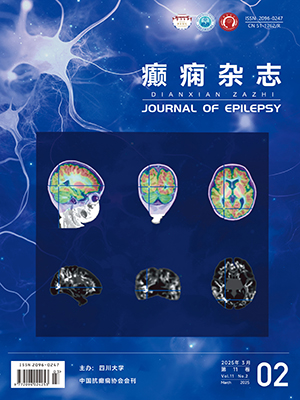| 1. |
Stretton J, Thompson PJ. Frontal lobe function in temporal lobe epilepsy. Epilepsy Research, 2012, 98(1): 1-13.
|
| 2. |
Diamond A. Executive functions. Annual Review of Psychology, 2013, 64(1): 135-168.
|
| 3. |
Miyake A, Friedman NP, Emerson MJ, et al. The unity and diversity of executive functions and their contributions to complex “frontal lobe” tasks: a latent variable analysis. Cognitive Psychology, 2000, 41(1): 49-100.
|
| 4. |
Berg AT, Berkovic SF, Brodie MJ, et al. Revised terminology and concepts for organization of seizures and epilepsies: report of the ILAE Commission on Classification and Terminology, 2005-2009. Epilepsia, 2010, 51(4): 676-685.
|
| 5. |
Zamarian L, Trinka E, Bonatti E, et al. Executive functions in chronic mesial temporal lobe epilepsy. Epilepsy Research and Treatment, 2011, 11: 1-11.
|
| 6. |
Longo CA, Kerr EN, Smith ML. Executive functioning in children with intractable frontal lobe or temporal lobe epilepsy. Epilepsy & Behavior, 2013, 26: 102-108.
|
| 7. |
Pan L, Guo D, Wang J, et al. Alterations in neural oscillations related to working memory deficit in temporal lobe epilepsy. Epilepsy & Behavior, 2021, 121: 108-116.
|
| 8. |
Joplin S, Gascoigne M, Barton B, et al. Accelerated long-term forgetting in children with temporal lobe epilepsy: a timescale investigation of material specificity and executive skills. Epilepsy & Behavior, 2022, 129: 108-113.
|
| 9. |
Celiker Uslu S, Yuksel B, Tekin B, et al. Cognitive impairment and drug responsiveness in mesial temporal lobe epilepsy. Epilepsy & Behavior, 2019, 90: 162-167.
|
| 10. |
Esteso Orduña B, Fournier del Castillo M de la C, Cámara Barrio S, et al. Cognitive and behavioral profiles of pediatric surgical candidates with frontal and temporal lobe epilepsy. Epilepsy & Behavior, 2021, 117: 107-118.
|
| 11. |
Bjørke AB, Østby Y, Grahl SG, et al. Cognition in adult patients with newly diagnosed non-lesional temporal lobe epilepsy. Epilepsy & Behavior, 2021, 116: 107-111.
|
| 12. |
Lima EM, Rzezak P, Guimarães CA, et al. The executive profile of children with benign epilepsy of childhood with centrotemporal spikes and temporal lobe epilepsy. Epilepsy & Behavior, 2017, 72: 173-177.
|
| 13. |
Uddin LQ, Yeo BTT, Spreng RN. Towards a universal taxonomy of macro-scale functional human brain networks. Brain Topography, 2019, 32(6): 926-942.
|
| 14. |
Li R, Zhang S, Yin S, et al. The fronto‐insular cortex causally mediates the default‐mode and central‐executive networks to contribute to individual cognitive performance in healthy elderly. Human Brain Mapping, 2018, 39(11): 4302-4311.
|
| 15. |
Van Calster L, D’Argembeau A, Salmon E, et al. Fluctuations of attentional networks and default mode network during the resting state reflect variations in cognitive states: evidence from a novel resting-state experience sampling method. Journal of Cognitive Neuroscience, 2017, 29(1): 95-113.
|
| 16. |
Burianová H, Faizo NL, Gray M, et al. Altered functional connectivity in mesial temporal lobe epilepsy. Epilepsy Research, 2017, 137: 45-52.
|
| 17. |
Oyegbile TO, VanMeter JW, Motamedi GK, et al. Default mode network deactivation in pediatric temporal lobe epilepsy: relationship to a working memory task and executive function tests. Epilepsy & Behavior, 2019, 94: 124-130.
|
| 18. |
姜家奇, 殷宏宇, 王晓虹. 单侧颞叶癫痫患者脑电图网络变化与执行功能的关系. 保健医学研究与实践, 2021, 18(5): 84-88.
|
| 19. |
Gao Y, Zheng J, Li Y, et al. Abnormal default-mode network homogeneity in patients with temporal lobe epilepsy. Medicine, 2018, 97(26): e11239.
|
| 20. |
Winston GP, Stretton J, Sidhu MK, et al. Structural correlates of impaired working memory in hippocampal sclerosis. Epilepsia, 2013, 54(7): 1143-1153.
|
| 21. |
Oyegbile TO, VanMeter JW, Motamedi G, et al. Executive dysfunction is associated with an altered executive control network in pediatric temporal lobe epilepsy. Epilepsy & Behavior, 2018, 86: 145-152.
|
| 22. |
Zhang C, Yang H, Qin W, et al. Characteristics of resting-state functional connectivity in intractable unilateral temporal lobe epilepsy patients with impaired executive control function. Frontiers in Human Neuroscience, 2017, 11: 609.
|
| 23. |
Bi B, Che D, Bai Y. Neural network of bipolar disorder: toward integration of neuroimaging and neurocircuit-based treatment strategies. Translational Psychiatry, 2022, 12(1): 143.
|
| 24. |
Zhou X, Zhang Z, Yu L, et al. Disturbance of functional and effective connectivity of the salience network involved in attention deficits in right temporal lobe epilepsy. Epilepsy & Behavior, 2021, 124: 108-118.
|
| 25. |
Zhang Z, Zhou X, Liu J, et al. Aberrant executive control networks and default mode network in patients with right-sided temporal lobe epilepsy: a functional and effective connectivity study. International Journal of Neuroscience, 2020, 130(7): 683-693.
|
| 26. |
Majerus S, Péters F, Bouffier M, et al. The dorsal attention network reflects both encoding load and top–down control during working memory. Journal of Cognitive Neuroscience, 2018, 30(2): 144-159.
|
| 27. |
Strýček O, Lamoš M, Klimeš P, et al. Cognitive task-related functional connectivity alterations in temporal lobe epilepsy. Epilepsy & Behavior, 2020, 112: 107-119.
|
| 28. |
Narenmandula B, Zhou X, Li Y, et al. Effects of white matter microstructure lesions on language and memory function in magnetic resonance imaging-negative temporal lobe epilepsy determined by diffusion tensor imaging. Neurol India, 2016, 64(6): 1233-1242.
|
| 29. |
Diao L, Yu H, Zheng J, et al. Abnormalities of the uncinate fasciculus correlate with executive dysfunction in patients with left temporal lobe epilepsy. Magnetic Resonance Imaging, 2015, 33(5): 544-550.
|
| 30. |
王后芬, 黄书蕾, 黄明明, 等. 左侧颞叶癫痫患者脑白质纤维结构完整性与执行功能研究. 第三军医大学学报, 2020, 42(14): 1414-1420.
|
| 31. |
Xu S, Xi J, Lin C, et al. Cognitive decline and white matter changes in mesial temporal lobe epilepsy. Medicine, 2018, 97(33): e11803.
|





 Baidu Scholar
Baidu Scholar